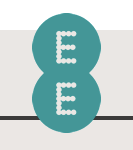The first — and still, the only — 4G network in the U.K. is now available to half the U.K.’s homes and businesses. Carrier EE said today it has switched on the network in 13 more towns and cities to hit the 50% population coverage mark five months after the network went live. EE has said it aims to reach 98% population coverage by the end of 2014.
The company has previously said its network rollout would reach 55% of the population by June, and is claiming it has speeded up this schedule. Today’s launch switches 4G on in Bradford, Bingley, Doncaster, Dudley, Harpenden, Leicester, Lichfield, Loughborough, Luton, Reading, Shipley, St Albans and West Bromwich, with another 30 towns and cities due to go live by the end of June bringing the total covered by the 4GEE rollout to 80.
EE confirmed to TechCrunch that it calls a town or city “switched on” when there is “in excess of 80% coverage in the centre” — so set your 4G coverage expectations accordingly. Towns and cities that EE claims as part of its 4G network will not have blanket coverage but rather a majority of coverage at the centre. An EE spokeswoman said that the 80% minimum “grows very quickly from launch to become near 100%” — but that’s still referring to the town or city centre only.
The PR exercise of being able to trumpet that a majority of the U.K. population is now ‘covered’ by its 4G coverage is important for EE as it needs to make the most of its head start over rivals O2, Vodafone and Three. They have all now secured the 4G-suitable spectrum they needed to start building their own 4G networks, although the smallest carrier, Three, appears to be in no rush — with CEO Dave Dyson telling Mobile News yesterday: “We’re in no rush to launch LTE. First we’ll see how 4G is positioned by O2 and Vodafone and look at how we position it. I’m fairly relaxed about it.”
At the end of the auction process last month, O2 said it anticipated a “summer 4G launch”, while Vodafone was less specific on its rollout schedule, saying only that it would launch a 4G network “later this year”.
Having a 4G head start hasn’t brought huge customer wins for EE yet. Last month it reported total 3G and 4G postpaid additions in Q4 of 201,000 — down from 250,000 postpaid net adds in Q3, and 313,000 in the year ago quarter, suggesting any benefit from being first to 4G has yet to be realised. Part of the issue is that postpaid customers are typically locked into contracts — of up to two years in duration — with little choice but to wait until the contract ends before switching providers. By which time EE’s rivals could have their own 4G networks up and running so building out coverage is key to winning the looming 4G marketing battle.
Carrier coverage claims are always an abstraction of a far more complex on the ground reality. Rollouts typically focus on switching on cell towers in a city or town centre where population density tends to be highest, and gradually expanding coverage from there — so even the 50 towns and cities that EE claims to have ‘switched on’ won’t enjoy full 4G coverage right from the city limits to the centre. We’ve reached out to EE to ask for details of the proportion of towns and cities covered in its rollout and will update this story with any response. Update: EE responded, see above.
Asked whether it counts the entire population of a town or city that it’s “switched on” towards its overall coverage percentage EE confirmed it does not do this, but counts only the relevant postcode areas. A spokeswoman said: “Total population coverage is calculated based on where the sites are radiating and the postcodes they cover.”
The problem of getting accurate data for cellular coverage maps is being tackled by crowdsourced coverage startup OpenSignal.
